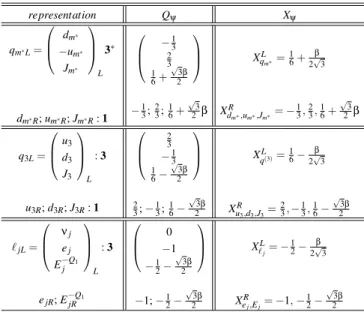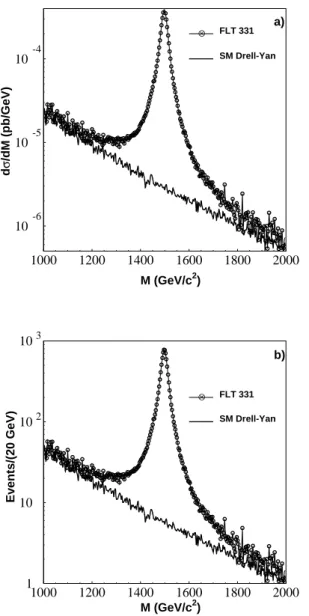Brazilian Journal of Physics, vol. 38, no. 3B, September, 2008 421
Z
′Production in 331 Models
J. G. Due˜nas, R. Mart´ınez, and F. Ochoa
Universidad Nacional de Colombia, Ciudad Universitaria Crr. 45 No. 26-85, Bogot ´a, Colombia (Received on 9 April, 2008)
We analyse the possibilities to detect a newZ′boson in di-electron events at LHC in the framework of the 331 model with right-handed neutrinos. For an integrated luminosity of 100f b−1at LHC, and considering a central valueMZ′=1500 GeV, we obtain the invariant mass distribution in the processpp→Z′→e+e−, where a huge peak, corresponding to 800 signal events, is found above the SM background. The number of di-electron events vary from 10000 to 1 in the mass range ofMZ′=1000−5000 GeV.
Keywords: 331 Models; Extra neutral gauge bosons; LHC physics
1. INTRODUCTION
In most of extensions of the standard model (SM), new massive and neutral gauge bosons, called Z′, are predicted. The presence of this boson is sensitive to experimental obser-vations at low and high energies, and will be of great interest in the next generation of colliders (LHC, ILC, TESLA) [1]. In particular, it is possible to study some phenomenological features associated toZ′ through models with gauge symme-trySU(3)c⊗SU(3)L⊗U(1)X,also called 331 models. These
models arise as an interesting alternative to explain the origin of generations [2–4], where the three families are required in order to cancel chiral anomalies. The electric charge is de-fined as a linear combination of the diagonal generators of the group
Q=T3+βT8+X I, (1) where β allow classify the different 331 models, T3 = 1/2diag(1,−1,0), andT8= (1/2
√
3)diag(1,1,−2). The two main versions corresponds toβ=−√3 [2, 3] andβ=−√1
3 [4]. In this work we search forZ′bosons in di-electron events produced inppcollisions at LHC collider in the framework of the 331 model withβ=−√1
3, which we denote as the Foot-Long-Truan (FLT) model.
2. THE FERMIONIC AND NEUTRAL GAUGE SPECTRUM
The fermion representations under SU(3)c⊗ SU(3)L⊗
U(1)Xread
b
ψL = ½
b
qL: ¡
3,3,XqL¢=¡3,2,XqL¢⊕¡3,1,XqL¢,
b
ℓL:¡1,3,XℓL¢=¡1,2,XℓL¢⊕¡1,1,XℓL¢, b
ψ∗L = ½
b
q∗L:¡3,3∗,−XqL¢=¡3,2∗,−XqL¢⊕¡3,1,−XqL¢,
b
ℓ∗L:¡1,3∗,−XℓL¢=¡1,2∗,−XℓL¢⊕¡1,1,−XℓL¢,
b
ψR = ½
b
qR: ¡
3,1,XqR¢,
b
ℓR:¡1,1,XℓR¢.
(2)
The second equality comes from the branching rules SU(2)L⊂SU(3)L. TheXprefers to the quantum number
as-sociated withU(1)X. The generator ofU(1)X conmute with
the matrices ofSU(3)L; hence, it should take the formXpI3×3,
representation Qψ Xψ
qm∗L=
dm∗
−um∗
Jm∗
L 3∗
dm∗R;um∗R;Jm∗R:1 −1 3 2 3 1 6+ √ 3β 2 −1 3; 2 3; 1 6+ √ 3 2β XL qm∗=
1 6+
β
2√3
XR
dm∗,um∗,Jm∗=− 1 3, 2 3, 1 6+ √ 3 2β
q3L= u3 d3 J3 L :3
u3R;d3R;J3R:1 2 3 −1 3 1 6− √ 3β 2 2 3;−
1 3; 1 6− √ 3β 2 XL q(3)=
1 6−
β
2√3
XR u3,d3,J3=
2 3,−
1 3, 1 6− √ 3β 2
ℓjL=
νj ej E−Q1
j L :3
ejR;E−jRQ1
0 −1 −1 2− √ 3β 2
−1;−1
2− √
3β
2
XL
ℓj=−12−
β
2√3
XR
ej,Ej=−1,− 1 2−
√ 3β
2
TABLE I:Fermionic content for three generations. We take m∗=1,2 and j=1,2,3
the value ofXpis related with the representations ofSU(3)L
and the anomalies cancellation. This fermionic content shows that the left-handed multiplets lie in either the3or3∗ repre-sentations. The fermionic structure is shown in Tab. I in the framework of a three family model
For the scalar sector, we introduce the triplet fieldχ with vacuum expectation value (VEV)hχiT=¡0,0,νχ¢, which
in-duces the masses to the third fermionic components. In the second transition it is necessary to introduce two tripletsρand ηwith VEVhρiT =¡0,νρ,0¢andhηiT = (νη,0,0)in order
to give masses to the quarks of type up and down respectively [5].
In the gauge boson spectrum associated with the group SU(3)L⊗U(1)X,we are just interested in the physical
422 J. G. Due˜nas, R. Mart´ınez, and F. Ochoa
Aµ = SWWµ3+CW µ
βTWWµ8+ q
1−β2T2 WBµ
¶
,
Zµ = CWWµ3−SW µ
βTWWµ8+ q
1−β2T2 WBµ
¶
,
Zµ′ = − q
1−β2T2 WW
8
µ+βTWBµ, (3)
where the Weinberg angle is defined as [6]
SW=sinθW=
gX q
g2L+ (1+β2)g2 X
(4)
andgL,gXcorrespond to the coupling constants of the groups
SU(3)L andU(1)X, respectively. It is important to note that
theZandZ′bosons in Eq. (3) are not true mass eigenstates, but there is aZ−Z′mixing angle that rotate the neutral sector to the physicalZ1andZ2bosons. However, the hadronic reac-tions are much less sensitive to theZ−Z′mixing than lepton reactions [1]. Thus, theZ−Z′ mixing can be neglected and we identify theZandZ′bosons as the physical neutral bosons.
3. THE NEUTRAL GAUGE COUPLINGS
Using the fermionic content from Tab. I, we obtain the neu-tral coupling for the SM fermions [6]
L
NCD =
gL
2CW £
fγµ ¡
gvf−gafγ5¢f Zµ+fγµ ¡
e
gvf−geafγ5¢f Zµ′¤, (5) where f isU= (u,c,t),D= (d,s,b)for up- and down-type quarks, respectively andN= (νe,νµ,ντ),L= (e,µ,τ)for
neu-trinos and charged leptons, respectively. The vector and axial-vector couplings of theZ boson are the same as the SM Z-couplings
gUv,N = 1
2−2QU,NS 2
W, gUa,N =
1 2, gDv,L = −1
2−2QD,LS 2
W, gDa,L=−
1
2, (6)
withQf the electric charge of each fermion given by Tab. I;
while the corresponding couplings toZ′are given by [7]
e
gUv,a,D = CW 2
q
1−β2T2 W
·
1
√
3
µ
diag(1,1,−1) +βT
2 W √
3
¶
± 2QU,DβTW2 ¤
,
e
gNv,a,L = CW 2
q
1−β2T2 W
· −1
√
3−βT 2
W±2QN,LβTW2 ¸
, (7)
where the plus sign (+) is associated with the vector cou-plingegv,and the minus sign (−) with the axial couplinggea.
The above equations are written forβ=−1/√3, which cor-responds to the FLT model. On the other hand, the differential cross section for the processpp(pp)¯ −→Z′−→ ff¯is given by [1]
dσ
dMdydz= K(M) 48πM3
∑
q
P[BqG+q(1+z2) +2CqG−qz], (8)
where
M = Mf f
z = cosθ
K(M) ≃ 1.3
y = 1/2 log[(E+pz)/(E−pz)]
P = s2/[(s−MZ2′)2+MZ2′Γ2Z′]
Bq = [(egqv)2+ (geqa)2][(gevf)2+ (geaf)2]
Cq = 4(geqvegqa)(gevfegaf)
G±q = xAxB[fq/A(xA)fq/B(xB)±fq/B(xB)fq/A(xA)]
x = Me±y/√z.
withMf f the invariant final state mass, z the scattering
an-gle between the initial quark and the final lepton in theZ′ rest frame,K(M)contains leading QED corrections and NLO QCD corrections,ythe rapidity,Ethe total energy,pzthe
lon-gitudinal momentum,√sthe collider CM energy,MZ′ andΓZ′
theZ′ mass and total width, respectively. The parametersBq
andCqcontain the couplings from Eq. (7) for the initial quarks
qand the final fermions f, while the parameterG±q contains the Parton Distribution Functions (PDFs) f(x),and the mo-mentum fractionx. We can consider the Narrow Width Ap-proximation (NWA), where the relationΓ2
Z′/M 2
Z′is very small,
so that the contribution to the cross section can be separated into theZ′ production cross sectionσ(pp(p)¯ →Z′)and the fermion branching fraction of theZ′bosonBr(Z′→ff¯)
σ(pp(p)¯ →ff¯) =σ(pp(p)¯ →Z′)Br(Z′→ ff¯), (9) From the analysis of Ref. [7] we can estimate that Γ2
Z′/MZ2′ ≈1×10−4. Thus, the NWA is an appropriate
ap-proximation in our calculations.
4. ZFLT′ AT LHC
The design criteria of ATLAS at LHC could reveal aZ′ sig-nal at the TeV scale. The expected features of the detector are [8]
a. ppcollisions at C.M. energy√s=14 TeV, b. Integrated luminosityL=100f b−1, c. Pseudorapidity below|η| ≤2.2
Brazilian Journal of Physics, vol. 38, no. 3B, September, 2008 423
FLT 331
⊗
SM Drell-Yan
d
σ
/dM (pb/GeV)
M (GeV/c2)
a)
10-6 10-5 10-4
1000 1200 1400 1600 1800 2000
FLT 331
⊗
SM Drell-Yan
Events/(20 GeV)
M (GeV/c2)
b)
1 10 102 103
1000 1200 1400 1600 1800 2000
FIG. 1: The plot a.) shows the cross section distribution as a function of the invariant final state mass forMZ′=1500 GeV in LHC. The plot b.) shows the number of events.
For this study, we use the CalcHep package [9] in order to simulate pp→e+e− events with the above kinematical criteria. Using a non-relativistic Breit-Wigner function and the CTEQ6M PDFs [11], we perform a numerical calculation with the following parameters
α−1=128.91, S2
W =0.223057, ΓZ′=0.02MZ′, (10)
where the total width ΓZ′ ≈0.02MZ′ is estimated from the
analysis performed in the Ref. [7]. The plot in Fig. 1a shows the invariant mass distribution for the di-electron system as final state, where we have chosen a central valueMZ′ =1500
GeV, which is a typical lower bound for FLT models from low energy analysis at the Z-pole [10], and which lies into
FLT 331
σ
(pp
→
Z
l →
e
+ e - ) (pb)
MZ, (GeV/c2)
a)
10-5 10-4 10-3 10-2 10-1
1000 1500 2000 2500 3000 3500 4000 4500 5000
331 FLT
SM
Number of events
MZ, (GeV/c2)
b)
10-2 10-1 1 10 102 103 104
1000 1500 2000 2500 3000 3500 4000 4500 5000
FIG. 2: The plot a.) shows the cross section as a function ofMZ′ in LHC. The plot b.) shows the number of events, where we plot the SM background.
the expected detection range for LHC. The Fig. 1b shows the number of events for the expected luminosity of 100f b−1. We also calculate the SM Drell-Yan spectrum in both plots with the same kinematical conditions, where we can see that the Z′signal exhibit a huge peak above the SM background with about 800 signal events.
On the other hand, we calculate the cross section for the same leptonic channel as a function ofMZ′, as shown by the
plot in Fig. 2a. The Fig. 2b shows the number of events, where the SM background is found to be essentially negligible for all the selected range. ForMZ′ =1 TeV, we get a huge
number of events, corresponding to 10000 signal events, while at the large mass limitMZ′=5 TeV, we find just 1 event per
424 J. G. Due˜nas, R. Mart´ınez, and F. Ochoa
5. CONCLUSIONS
In the framework of the FLT 331 model, we have analyzed theZ′production assuming the design criteria ATLAS detec-tors at LHC collider. For an integrated luminosity of 100f b−1 in LHC and considering a central value ofMZ′ =1500 GeV,
we find a narrow resonance with 800 signal events above the SM background. If the Z′ mass increases, the
num-ber of events decreases from 10000 to 1 signal event in the MZ′ =1000−5000 GeV range. It is important to note that
the PPF model, corresponding toβ=−√3 in Eq. 1, exhibit a typical lower boundMZ′=4000 GeV [10], which is near to
the LHC discovery potential limit.
This work was supported by Colciencias.
[1] For reviews, see J. Hewett and T. Rizzo, Phys. Rept.183, 193 (1989); A. Leike, Phys. Rept.317, 143 (1999); T. Rizzo, hep-ph/0610104; P. Langacker, hep-ph/0801.1345.
[2] F. Pisano and V. Pleitez, Phys. Rev. D46, 410 (1992); R. Foot, O. F. Hernandez, F. Pisano, and V. Pleitez, Phys. Rev. D 47, 4158 (1993); V. Pleitez and M. D. Tonasse, Phys. Rev. D48, 2353 (1993); Nguyen Tuan Anh, Nguyen Anh Ky, and Hoang Ngoc Long, Int. J. Mod. Phys. A16, 541 (2001).
[3] P. H. Frampton, Phys. Rev. Lett.69, 2889 (1992); P. H. Framp-ton, P. Krastev and J. T. Liu, Mod. Phys. Lett.9A, 761 (1994); P. H. Frampton et. al. Mod. Phys. Lett.9A, 1975 (1994). [4] R. Foot, H. N. Long, and T. A. Tran, Phys. Rev. D50, R34
(1994); H. N. Long, ibid.53, 437 (1996);ibid,54, 4691 (1996);
Mod. Phys. Lett. A13, 1865 (1998).
[5] Rodolfo A. Diaz, R. Martinez, and F. Ochoa, Phys. Rev. D69, 095009 (2004).
[6] Rodolfo A. Diaz, R. Martinez, and F. Ochoa, Phys. Rev. D72, 035018 (2005).
[7] A. Carcamo, R. Martinez, and F. Ochoa, Phys. Rev. D73, 035007 (2006).
[8] M. Dittmar, A. S. Nicollerat, and A. Djouadi, Phys. Lett. B583, 111 (2004)
[9] http://www.ifh.de/ pukhov/calchep.html

